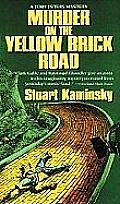The Symbolic Weight of a Dead Munchkin
At the Mysterious Press, Greg Rucka, scripter of Gotham Central and other well-regarded comics, contributed an essay on how reading Stuart Kaminsky’s Murder on the Yellow Brick Road changed his life.
Granted, he didn’t have much of a life before then. Which is to say, he was an ordinary ten-year-old kid—nothing wrong with that. But, thanks to a bookseller who obviously hadn’t read what she or he was recommending, little Gregory went straight from Encyclopedia Brown and a few chapters of the Hardy Boys to Toby Peters, private eye at the height of the Hollywood studio system.
But I never found the emotional connection with Kaminsky’s stories that Rucka did. In fact, in every summer of the late 1970s and early 1980s I probably drifted off in the middle of a Toby Peters mystery. The days were hot, and we didn’t have air-conditioning. I preferred Harry Kemelman and other authors. But for years I did keep trying each new Toby Peters book.
Granted, he didn’t have much of a life before then. Which is to say, he was an ordinary ten-year-old kid—nothing wrong with that. But, thanks to a bookseller who obviously hadn’t read what she or he was recommending, little Gregory went straight from Encyclopedia Brown and a few chapters of the Hardy Boys to Toby Peters, private eye at the height of the Hollywood studio system.
I'm ten, and my mother hands me this book. On the cover there's a Munchkin with a tiny knife in his chest, and he's lying on the Yellow Brick Road. There's a thin thread of blood that's escaped, and now runs between the bricks. The Munchkin lies in a puddle of light, and the Yellow Brick Road bends away, into murkier shadows. You can just see the lamp itself on the right, but barely, hinting that this isn't Oz.I’m a few years older than Rucka, and I read Kaminsky’s novels as they appeared. I don’t know if I started with Murder on the Yellow Brick Road because of my Oz interest; the first may have been Bullet for a Star, which came out when I was eleven. I was already reading at a high level, including some of my mother’s adult mysteries. I’d read a number of books about prewar Hollywood. I didn’t realize till much later how much Kaminsky played off the southern-California school of private eye novels.
I stared at that cover for a long time. The title threw me. I was ten, I was a boy, and anything smacking of Oz also reeked of "girl," so I was wary. But that cover, I look at it today - it's to my right as I type this - and I can still remember the delicious sense of menace it gave me, the double-dog-dare to come inside. . . .
The plot, in a nutshell, is this: Judy Garland hires private investigator Toby Peters to keep the murder of the Munchkin out of the papers. Toby learns that Garland's life is in danger. The bodies start stacking up.
Straightline enough. Except I'm ten, and aside from the fact that Raymond Chandler and Clark Gable also show up in the novel (I had heard of the first, had seen films of the second), what Toby uncovers isn't just dead Munchkins. No, no, see, because someone's been making porn films on the old Wizard of Oz sets.
And then Toby has sex in a dentist's chair.
But I never found the emotional connection with Kaminsky’s stories that Rucka did. In fact, in every summer of the late 1970s and early 1980s I probably drifted off in the middle of a Toby Peters mystery. The days were hot, and we didn’t have air-conditioning. I preferred Harry Kemelman and other authors. But for years I did keep trying each new Toby Peters book.



2 comments:
I picked up Murder at an Oz Convention, I think. Or maybe the used bookstore. I'm not sure. I remember being disappointed, but otherwise remember nothing.
There's a more recent mystery that had Oz themes - set in an Oz carnival - that I remember also being disappointed by. It also has a fun cover - Hard Road: a Cat Marsala Mytsery by Barbara D'Amato. I love the skull in the Tin Woodman's head. The cover, I mean.
In Hard Road I was mainly annoyed by undigested lumps of authorial research - a common mystery flaw.
I read Hard Road, too, and thought the crucial clue was too much of a stretch. That book also came with an essay by the author’s son equating the Gargoyles of Dorothy and the Wizard in Oz with Native Americans.
Post a Comment